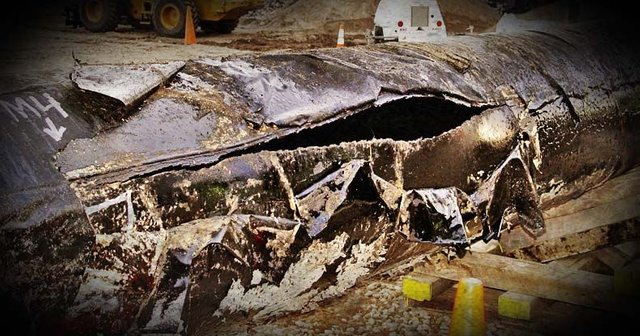
Just after President Donald Trump signed sweeping executive actions greenlighting both the Keystone XL and Dakota Access Pipelines, a 12-inch underground diesel pipeline in Iowa spilled an estimated 138,600 gallons of fuel into agricultural land.
“It’s a big one — it’s significant,” Jeff Vansteenburg, field office supervisor for the Iowa Department of Natural Resources, told the Des Moines Register.
According to federal authorities, this is the largest diesel spill in the United States since 2010.
An investigation is now underway to determine the cause of the rupture and cleanup crews have thus far removed “about 25,000 gallons of diesel and a slush-diesel mixture” from the area near Hanlontown.
Magellan Midstream Partners L.P. operates the pipeline, which has sensors to alert for any sure problems occurring — but company spokesman Bruce Heine said the cause of the rupture remains unclear.
As Vansteenburg explained, for perspective, sizable underground diesel tanks at a typical gas station hold between 10,000 and 15,000 gallons — this leak spilled enough fuel to supply ten stations.
“The product is under pressure,” he continued, “so as soon as a leak develops, it starts coming out pretty fast.”
Karen Grimes, spokesperson for the Iowa Department of Natural Resources, noted for the Register neither a nearby wildlife protection area nor Willow Creek had been contaminated by the spill, which was discovered on Wednesday.
“They found that it’s basically pooled into a farm field that’s near the break and has not reached the water in the state,” Grimes explained. “There’s a little creek, but it has not reached any surface waters at this time.”
Although the 939-acre Hanlontown Slough Waterfowl Production Area nature preserve sits just south of the spill, David Miller of the Department of Natural Resources told the Globe Gazette, “There's a big pool of diesel fuel out in a field and it has not gotten into Willow Creek or the Hanlontown Slough as far as we can tell,” and Magellan’s crews are “going to recover all the liquid product and they're going to excavate all the contaminated soil.”
Despite the size of the spill, the Worth County Sheriff’s Office claimed no evacuations were necessary and there was no immediate risk to public health.
Officials from the Environmental Protection Agency and the Iowa Department of Natural Resources initially responded to the scene, and the leak has reportedly since been contained.
Magellan deployed vacuum and tanker trucks to the scene to contain and collect the pooled fuel, which will then be transported to the company’s Clear Lake terminal, reports the Register. Once the liquid portion of the leak has been collected, crews will remove contaminated soil from the area.
NPR, noting maps of the pipeline have been redacted from the public, reports a “safety plan submitted by the company to the U.S. Department of Transportation in 2014 lists the pipeline, which runs through Illinois, Iowa, Minnesota, North Dakota, South Dakota and Wisconsin, as a transport route for multiple refined oil products, "including Diesel, Gasoline, Jet fuel, Natural gasoline, [Naphtha], Propane, Natural Gas, Butane.”
Although the leak occurred just three miles north and one mile east of Hanlontown — and a half mile west of Interstate 35 — officials insisted no evacuation was necessary. A stretch of road had to be closed to the public to allow Magellan crews access to the contaminated area.
Initial reports from Magellan assessed the size of the leak to be around 63,000 gallons, or 1,500 barrels — less than half the current estimate of 3,300 barrels.
Magellan’s last major accident occurred just three months ago in rural Nebraska near Decatur, reported the Omaha World-Herald, when a pipeline carrying anhydrous ammonia burst, releasing a cloud of the deadly gas which took the life of a farmer who drove through the plume. Around 40 people from 23 households were evacuated as a precaution.
As a number of bitter battles rage to halt various pipeline construction projects around the country, this 138,600 gallon diesel fuel spill serves as a potent reminder claims of safety from the oil and gas industry are merely relative. Pipelines, technically, are indeed a safer means of transport for fossil fuel products than trains or tanker trucks — but the lesser number of spills doesn’t quantify that pipeline accidents release far larger amounts of product.
As public media project, Inside Energy, noted,
“According to data from federal regulators, there is actually a low probability of a pipeline accident. But when there is an accident, the impact can be huge.”
@tftproject, your post has been chosen by @STEEMNEWS.ONLINE as one of today's promoted posts for its excellent content. We've upvoted, resteemed and published it through Facebook & Twitter.
As the author of a SNO featured article, you've been awarded one TRAIL coin. Please stop by the SteemTrail Discord server to learn more about how to claim your TRAIL coin. You will need an Open Ledger account to do so.
STEEMNEWS.ONLINE is the @SteemTrail for #news and watches the #steemnews tag most closely. Please consider supporting excellent news articles by making steemnews.online one of your operators on Streemian, in addition to steemtrail.
Thank you for your hard work and contribution of excellent content to Steemit.

If you would rather not be promoted by STEEMNEWS.ONLINE, please inform us by replying to this comment and we will honor your request.
Downvoting a post can decrease pending rewards and make it less visible. Common reasons:
Submit
Hi! I am a robot. I just upvoted you! I found similar content that readers might be interested in:
http://thefreethoughtproject.com/diesel-pipeline-spill-iowa/
Downvoting a post can decrease pending rewards and make it less visible. Common reasons:
Submit
Sigh... "it will never happen!" They said....
Downvoting a post can decrease pending rewards and make it less visible. Common reasons:
Submit